


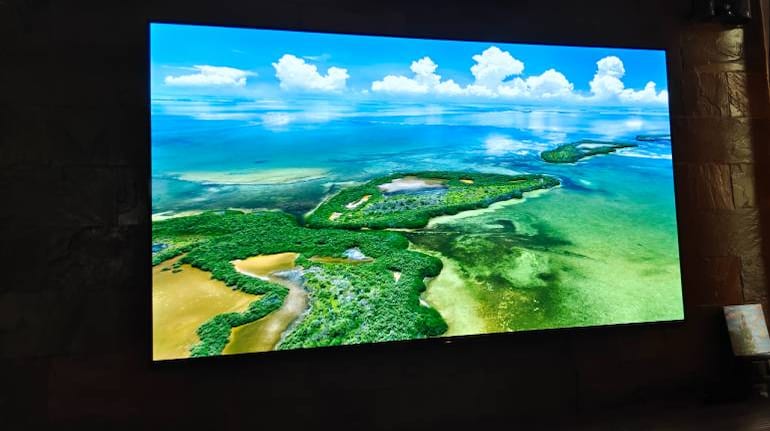
In the past five years, the number of TV brands in the market has grown considerably. The competition has made feature-rich, high-resolution TVs more accessible to consumers. This trend is ever-so evident in India, where brands like Xiaomi, TCL, and Vu growing in popularity for their affordable, feature-rich smart TVs. The intense competition has also forced brands like LG, Sony, and Samsung to introduce more affordable options. But that isn’t the case with the new Sony Bravia A80J OLED TV.
However, the A80J is no ordinary OLED TV, there’s definitely more to it than meets the eye. So, without any further delays, let’s take a dive deep into the specs and features of Sony’s premium OLED TV and find out if it is worth the price.
PriceThe Sony A80J is a premium 4K OLED TV that doesn’t come cheap. At a starting price of Rs 2,49,000, the Bravia XR A80J is significantly more expensive than other OLED TVs in India. Additionally, our 65-inch model will set you back Rs 3,39,900 and there’s a 77-inch model for Rs 6,99,900. The A80J is available for a few thousand less on Croma, Vijay Sales, and Reliance Digital – Rs 1,89,990 for the 55-inch, Rs 2,89,990 for the 65-inch, and Rs 5,49,990 for the 77-inch screen size.
DesignSony’s A80J OLED sits right under the flagship A90J but sets itself apart with a unique design. On the front, the company opts for a nearly bezel-less screen with a metallic Sony logo on the bottom. The TV comes with a two-piece aluminium stand that can be installed in three different ways. The standard position sees the metal feet positioned at a distance from one another and is ideal for larger tablets, although the feet can be repositioned closer together in case your table isn’t big enough.
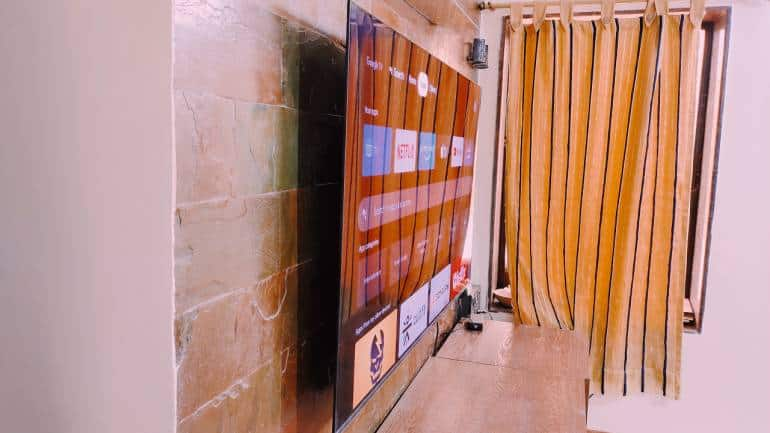
Lastly, you can also use the stand to raise the border of the TV to accommodate a soundbar underneath without obstructing the screen. However, you will still require a large table as the feet extend to the edges of the TV. There’s no doubt that the A80J exudes class with its super thin panel area. But that’s pretty much the case with most OLED TVs because of the lack of a backlight.
However, the section where most of the TV’s hardware is housed is bigger than the A90J. The enclosure is made of plastic and attached to the back of the panel but doesn’t take up too much space at the back. The TV also comes with a standard wall mount and it was quite annoying to see no HDMI cable included in the box. Getting back to the design, every aspect of the Bravia A80J’s design is aimed at offering the user a seamless and immersive experience, and on that front, it passes with flying colours.
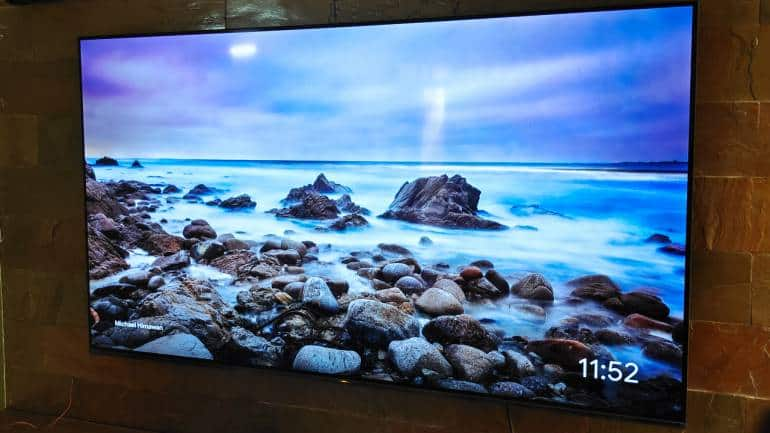
The Sony Bravia XR A80J OLED TV comes with a ton of connectivity options. While the power input is located on the right, the remaining ports sit on the left. A coaxial cable connector, an Ethernet port, optical audio out, three HDMI ports, one USB port, and a port for an RS-232C remote, all sit on an area on the back of the TV’s enclosure, while the rest of the ports are located on the side of the enclosure. There are six ports on the left side that face outwards, including two ports for composite video, a remote IR in, an HDMI port, and two USB ports.
The good part is that you get two HDMI 2.1 ports here (Port 3 and 4). The bad news is that only two of the four ports support the standard. The other two ports use only HDMI 2.0b. However, two HDMI 2.1 ports were more than sufficient. The HDMI two ports are game-changing for next-gen PS5 and Xbox Series X console owners as they support 4K resolution at 120Hz with HDR, variable refresh rate (VRR), and auto low latency mode (ALLM).
PerformanceSony’s XR A80J OLED TV uses an LG panel but the real magic lies within the TV’s processor. Image processing has long been a strength of Sony and that strength is very much evident here. The A80J is powered by Sony’s Bravia XR Cognitive Intelligence Processor which is impressive, to say the least. The TV does an excellent job of processing colours accurately with striking HDR highlights and perfect blacks. Sony’s XR processor can also estimate the main focal point in a scene and enhance the sharpness of the particular part of the screen you are focusing on. It is quite hard to notice as it is not a feature that can be turned on or off, but I’m just going to take Sony’s word for it, given the amazing picture quality on this TV.

The A80J can get quite bright for an OLED TV, which is not known to be the best when it comes to brightness. Is it bright enough to be used in a room hit by direct sunlight; I’d say no, it isn’t. The panel’s semi-glossy surface tends to handle reflections quite well, but I wouldn’t recommend placing the TV in front of an open window. The A80J also comes with XR OLED Contrast, which automatically adjusts brightness on the fly to boost lights and deepen blacks while maintaining detail in the scene.
While native 4K content looks spectacular on the A80J, there’s not a lot of 4K HDR content available. My Tata Sky set-top box was limited to 1080p content. However, Sony’s upscaling is pretty much as good as it gets. You can see that the A80J is doing a lot of work with 480p, 720p, and 1080p content. The XR processor can make significant adjustments to contrast and gamut with whatever little information it has to work with. You can also use the CineMotion feature for enhancements to low-bitrate streams. There’s good upscaling and bad upscaling, and then there’s Sony’s top draw upscaling.

The TV supports various HDR formats including HDR10, HLG, and Dolby Vision. It also has the ATSC 3.0 tuner, which delivers improved over-the-air reception receiving broadcasts in pristine 4K resolution with 3D audio support. Moreover, the A80J is IMAX Enhanced certified, meaning it's optimised for high-fidelity picture and sound.
The A80J is also one of the best OLEDs around for gaming, capable of supporting Xbox Series X and PS5 consoles and PCs that can run titles at 120fps in 4K resolution. The TV has a maximum refresh rate of 120Hz and has a variable refresh rate (VRR) and Auto Low Latency Mode (ALLM). However, only two of the four HDMI ports support the HDMI 2.1 standards, which means 120Hz support is only available through two of four ports.

In the TV’s dedicated Gaming mode, Sony claim that the TV has a super low response time for 8ms at 120fps. The reduced input lag with a high refresh rate makes this TV ideal for competitive gaming as well. Unfortunately, VRR and ALLM are not yet supported on the A80J, but Sony has promised to deliver these features via a software update soon. Additionally, there is no Nvidia G-Sync or AMD FreeSync support like you get on the LG C1 series. With the high-refresh-rate support and super-low response time, the A80J is an excellent TV for gaming, but there are definitely quite a few features that are lacking here, making it the one area where the TV doesn’t meet the exceedingly high standards, primarily set by Sony.
SoundIf you are going to splurge around two lakhs or more on a TV, you might as well get a good sound system to match. But if you don’t want to go all out on a new speaker system or if you don’t want to spend another penny, then you’re in luck because the A80J sounds amazing. Sony’s Acoustic Surface Audio+ technology uses the screen as the speaker for the TV with the aid of two actuators and two subwoofers. The TV also supports Dolby Atmos and 3D Surround Upscaling, which helps create a surround sound experience without the need for additional speakers.
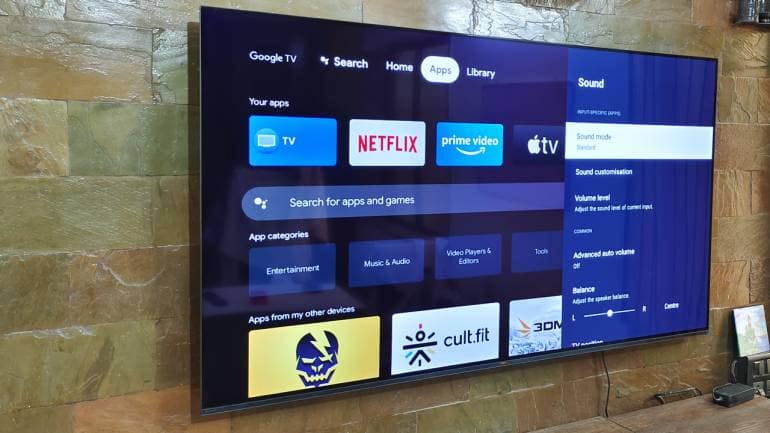
Additionally, the built-in speakers can be used as a center channel speaker in a surround sound setup. I won’t lie, the speakers do show their legs at max volume with quite a bit of distortion, while there’s not much bass and depth to the sound. However, the TV delivers excellent sound at moderate volumes. The overall sound profile is well balanced with crystal clear vocals. Voice Zoom 2 also detects and enhances dialogue so you can hear it clearly no matter what’s happening in the rest of the scene.
The Bravia XR A80J also has an automatic room EQ that leverages the microphone and the remote to measure and adjust the speaker output based on how the room you’re sitting in reacts to sound. You cannot do this process manually, but you can configure it to different seating positions in the room in mere seconds to get the best out of the speaker system. It is amazing to see the time and effort put into the A80J’s speaker system. Sure, the A80J’s in-built speakers don’t compare to a good soundbar with a subwoofer, but as far as OLEDs go, the sound is just about the best out there.
Google TV and RemoteSony’s new premium OLED TV uses Google TV, which is a big step up from the previous generation Android TV. One of the greatest benefits of using Google TV is that once it has been setup up on one device, it brings all the important settings to other devices running on Google TV. Additionally, the interface is much cleaner than most versions of Android TV. There’s a new ‘Search’ bar on the top that searches content across different apps by typing it out or using your voice. You also get a personalized ‘Home’ page (For You), with recommending movies and shows from different platforms.
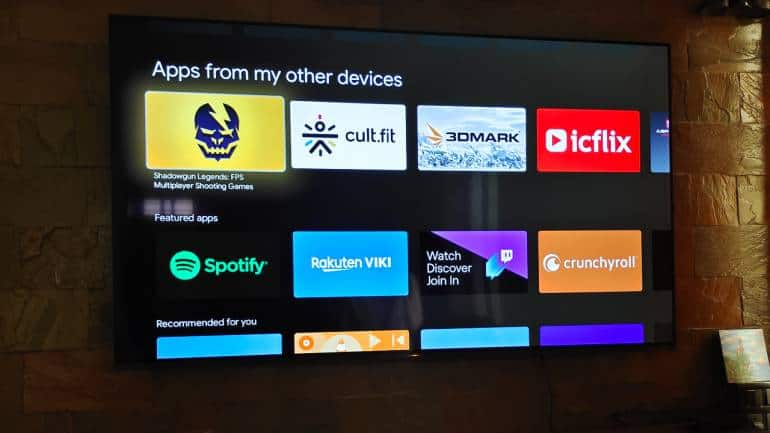
The Apps section gives you access to recommend apps as well as installed apps, while Library gives you access to saved content. Google TV’s recommendations are pretty solid and you can also add content across platforms to your Watchlist, which sits in Library. The Sony A80J also comes with Chromecast and AirPlay support. It also supports Amazon’s Alex and Apple’s HomeKit. You also have access to the Play Store to search for a whole host of apps.
Since the TV also comes with in-built assistant support, you can search content, open apps, switch between inputs, etc. using your voice hands-free. The remote itself is awesome. While I understand the appeal of small, minimalist remotes, the remote here is far more practical. Apart from dedicated buttons for popular OTT platforms, the remote also had a dedicated Google Assistant button, several multimedia buttons, and more.

While the voice assistant wasn’t always accurate when using it directly through the TV, pushing down on the Assistant button on the remote always yielded accurate results. Additionally, you can easily sync the remote to a set-top box and use it to operate channels on the box. Google TV helps Sony take the entertainment experience to the next level, while the remote is perfectly designed to make life so much easier.
VerdictAll things considered, the Sony Bravia A80J OLED TV is an excellent TV, but should you buy it? At a starting price of Rs 1,89,990, the A80J is quite expensive, going in the opposite direction of the current value trend. You will find a few Sony and LG models available for a much lower price. That being said, none of them is the A80J. The picture quality on the A80J is arguably the best in the industry and can challenges both QLED and OLED TVs models that cost significantly more than it. What Sony offers with the A80J is flagship picture quality for a ‘not quite’ flagship price.
And the A80J doesn’t just stop at class-leading picture performance, it also delivers exceptional sound. Then there’s the clean and convenient Google TV interface. Add to that a ton of audio and visual features to make the overall home entertainment experience as good as possible, and you now have one of the best TVs in the Indian market. And even though this is not the best TV for gaming, it certainly has a ton of great gaming features with more to come in the future.
The two scenarios where I wouldn’t recommend the A80J are if you watch TV in a very bright room or if you watch the news for several hours a day (Which could lead to burn-in in the long run). However, to look at the Sony Bravia XR A80J and stop at its price is criminal, there is so much more going on here. Sony seems to have found the ultimate sweet spot between price and performance, earning the A80J an easy recommendation.

Discover the latest Business News, Sensex, and Nifty updates. Obtain Personal Finance insights, tax queries, and expert opinions on Moneycontrol or download the Moneycontrol App to stay updated!
Find the best of Al News in one place, specially curated for you every weekend.
Stay on top of the latest tech trends and biggest startup news.